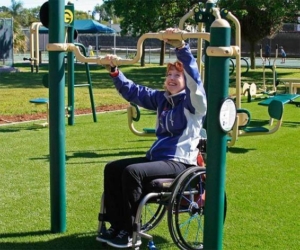Older Adults
The terms active aging and healthy aging are often used to refer to motivated groups of older adults interested in improving their quality of life. Exercise and physical activity that focus on balance, mobility, strength, cognitive function, and bone health are especially helpful for this demographic. Movement training that helps combat sarcopenia, muscle loss attributed to aging, aids in fall prevention, and fosters the ability to move from the ground to standing positions which can provide older adults with confidence and improved functional ability.
Recommendations for Instructors:
- – Trainers should get to know any limitations or issues of an older participant
- – Focus on core work involving bracing and stability, as opposed to spinal flexion.
- – Emphasize exercises that activate the back and foster healthy posture.
- – Include movements that help improve balance, stability, and mimic tasks of daily life, including getting up off the ground, reaching overhead and rotating safely.
- – Encourage participants to start with smaller ranges of motion before moving to larger, helping them move proximal to distal.
- – Focus on building community and providing opportunities to create social interaction and engagement.
- – Incorporate longer warm ups and cool downs, and allow enough time for transitions during class.
- – Be aware of cues, understanding that participants may have visual and auditory limitations.
Youth
For children and adolescents aged 2-19 years, the prevalence of obesity between 2015 and 2016 was 18.5% and affected about 13.7 million children and adolescents (Hales et al, 2017). Lack of regular physical activity can impact growth and development, as well as foster a lifestyle prone to obesity and other chronic diseases. Helping youths get more physical activity can create healthy habits for a lifetime.
Recommendations for Instructors:
- – The thermoregulatory systems of children are not as mature as adults, so frequent opportunities for hydration breaks and rest should be given, especially in hot and humid weather.
- – Place an emphasis on having fun and making physical activity enjoyable.
- – Check in regarding intensity using simple terms, for example easy, hard, and very hard.
- – Emphasize form and technique during strength training for safety.
- – Be sure youths are accompanied by a parent or adult, or that their participation meets the established rules outlined by the recreation department.
Pregnant and Postpartum Women: Exercise can be very beneficial for participants who are pregnant or just returning to exercise after having a baby. Physical activity may help pregnant women reduce fatigue, maintain cardiovascular health, mitigate back pain, reduce anxiety, and improve sleep quality, among other things. After giving birth, exercise may help alleviate and/or ward off depression, aid in weight loss, and restore pre-pregnancy fitness levels.
Recommendations for Instructors working with Pregnant Participants:
- – Design workouts that will reduce intensity and incorporate more rest breaks. Provide modifications for movements that may require balance, require quick changes in direction or are high impact in nature.
- – Focus on exercises to improve posture and to strengthen the core, especially those requiring stabilization and bracing, versus spinal flexion.
- – After the first trimester, avoid exercises that require lying prone or supine. Provide alternate position options, including side-lying, angled supine, quadruped on hands or elbows, and standing.
- – Encourage frequent hydration breaks, offer longer warm up and cool down segments, and promote proper thermoregulation.
- – In general, avoid programming that includes repetitive jumping and bouncing, and encourage participants to only move through comfortable ranges of motion.
- – Encourage participants to work at an intensity that is moderate, avoiding extremely high heart rates, and to speak with their doctor before beginning any exercise program.
- – Instructors should be aware that every pregnancy is unique, and experiences and parameters may vary greatly from one woman to the next.
- – Call EMS if any questionable situation arises or participant’s condition declines.
Recommendations for Instructors working with Postpartum Participants:
- – Encourage participants to start slowly and gradually move towards higher intensity.
- – Emphasize the need for staying hydrated and wearing supportive sports bras, especially if nursing.
- – Encourage participants to seek specialized care for rehabbing abdominal trauma, especially if diastasis recti has occurred.
- – Be sure the participant has obtained medical clearance to engage in exercise, noting any limitations, including those that may result from having a C-section.
Wheelchair Users: The FitLot Circuit Training program is wheelchair accessible and aims to create an inclusive environment. For individuals using wheelchairs, exercise can increase the ability to perform activities of daily living, increase physical independence, improve self-confidence, and create opportunities for social engagement. All wheelchair users should obtain clearance from their physician before beginning an exercise program.
Recommendations for instructors:
- – Wheelchairs should be in the locked positions before beginning an exercise, and powered mobility devices should be turned off.
- – Instructors must pay special attention to stability, as tipping over could cause injury or death.
- – Trainers should assist participants and act as a spotter when new exercises are attempted or equipment is used for the first time.
- – Ensure that the maximum weight capacity of the chair or mobile device is not exceeded by additional exercise weight.
- – Proper positioning is essential for safety when using equipment, so trainers should check the chair position and use extra supports to keep the chair stationary if needed.
- – Straps or safety belts can be used to keep individuals secure during exercise.
- – Stability of chairs may be improved by adjusting castor position, rear axle position, use of a weight or front hold on foot support, leaning, and/or use of restraints.
- – Participants may need to adjust holds or grips due to specialized gloves or protective hand equipment.
- – Trainers can find more information by referencing this link:

